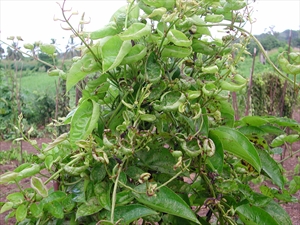- Worldwide distribution. There are many strains of the fungus attacking crops and weeds. An important disease.
- A wet weather fungus mainly on greater yam. Spots on young leaves expand rapidly causing them to fall early. Shoots die back, and old leaves turn black. New shoots grow from the set, but if they become infected, these die back, too. Often, there are no tubers, or just many small ones.
- Spread occurs when spores are moved in wind-driven rain and, perhaps, long distance in planting sets.
- Cultural control: plant early ahead of rainy season; check sets for rot; interplant with maize; do not weed when plants are wet; collect and burn trash after harvest; resistant varieties; 3-year crop rotation.
- Chemical control: copper, chlorothalonil, or mancozeb.






